EmpireBus NXT distributed power, gone NMEA 2000 & beyond
I keep hearing good things about EmpireBus NXT, the second generation distributed power and control system developed by the Swedish firm Trigentic AB, and I’m beginning to understand why. It must have been a hard decision to completely redesign the original CLC system for such a tentative, low-volume niche market, but I’m sure I’m not the only one who appreciates the change from proprietary CANbus to NMEA 2000 for primary data communications. And, holy cow, look at all the other I/O they added. Aside from switches on the N2K bus, that 16-channel DC Module can be controlled with a 2-way wireless fob, or via Ethernet/Internet, or via a GSM cellular phone…even via an iPhone app purportedly…
I was reminded of EmpireBus yesterday when Gary Pacey of Australian distributor Outback Marine sent me a press release about its install (views below) on the first Argus E35 power cat. Apparently Pacey also runs Argus and he sounds quite excited about debuting the boat loaded with Outback’s cutting edge systems portfolio at the Sanctuary Cove Boat Show later this month. He says he’s also willing to write up a detailed report on how EmpireBus NXT installs and works for Panbo…
I like that idea as these distributed power systems are a new world most of us know very little about, and Pacey seems willing to reveal the problems as well as the benefits. For instance, he’s put up a short but humorous YouTube video showing how the fancy wiper controls built into EmpireBus NXT misfired during the first sea trial (apparently they’re working fine now). That’s just one of many features — like the mode switches below, which beat the heck out of trying to remember which circuits you want on when underway, etc. — that you can read about on Trigentic’s NXT pages. And it seems like they’ve just gotten started given all the ways the system can be accessed. Pretty intriquing, don’t you think?


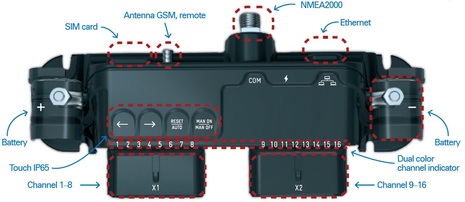
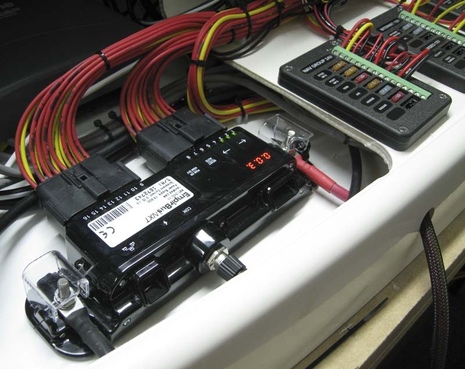
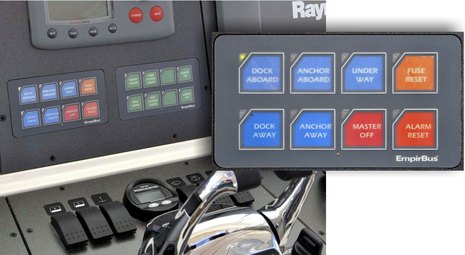
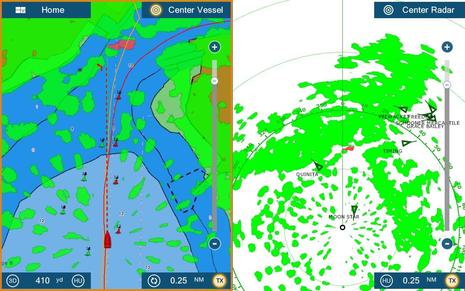


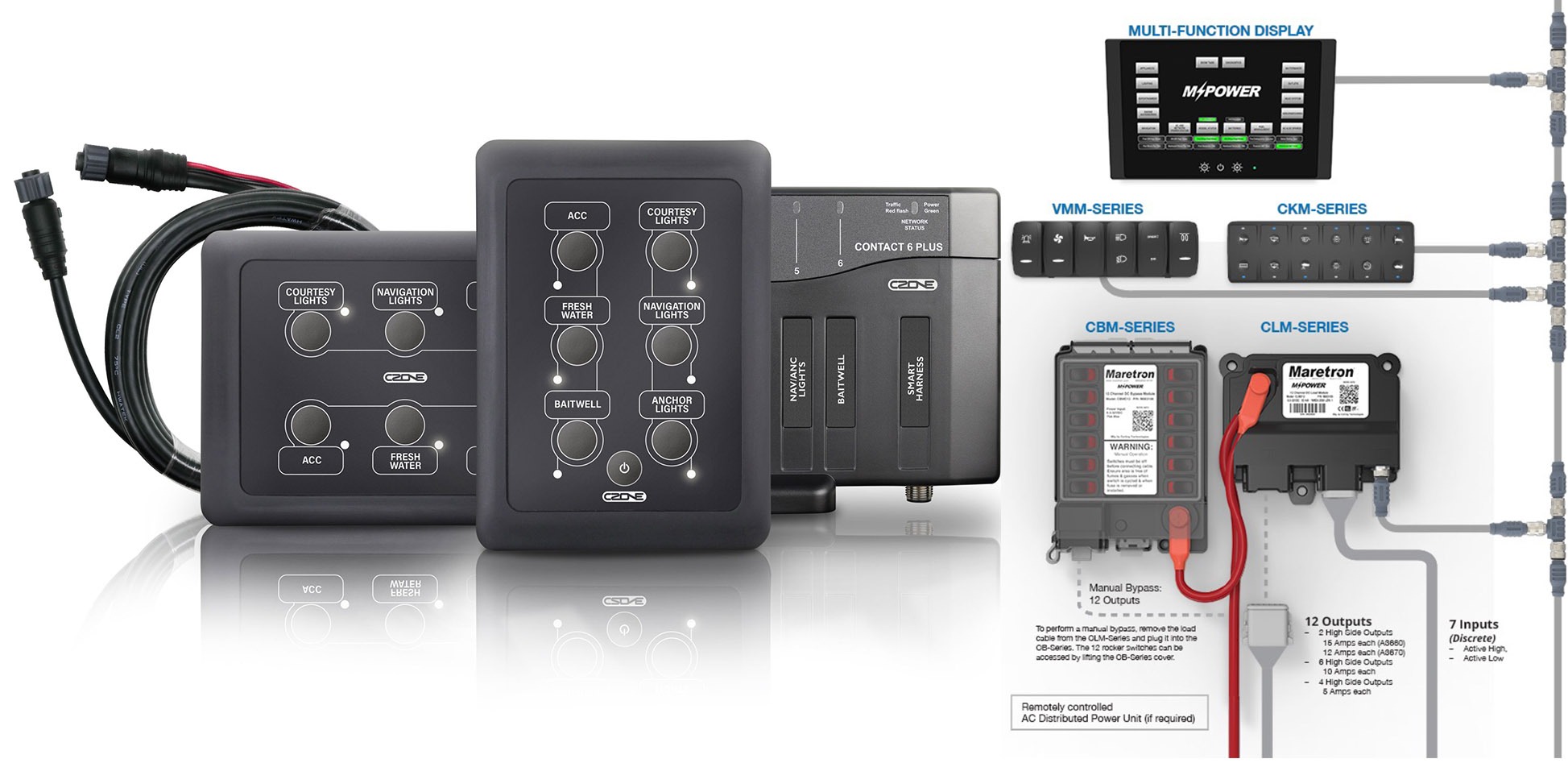







In other distributed power news, DSS Omni-Bus is used to control the hydraulic swim platform that helped win the Cobalt A-25 bowrider an innovation award: http://goo.gl/xsAWn
Trailer Boats award info: http://goo.gl/sltGj
Also, I did manage to get a pile of C-Zone equipment from Spain to Maine — apparently it looked “unusual” in my checked bag, which caused a delay — and plan to test it soon.
Interesting? For sure. The monitoring functionality alone might be worth the (hard to determine) cost. And it’s nice to see N2K catching on.
Mode buttons instead of item-by-item switching is something I think will catch on with more complex systems. You already see this in car, industrial and aircraft applications, and it makes a lot of sense.
The self-adapting replacement feature should go a long way towards alleviating some of the problems with distributed systems. It looks like replacement NXT parts automatically figure out the topology and get their configuration data from the rest of the network, without manual reprogramming.
I’ve yet to see anything that clearly addresses cost and long-term reliability, though. Prices seem to be by quotation only, making it hard to compare systems. And 9 years (the age of the oldest CLCs) is one thing; how will they hold up for 25 years? Have accelerated aging tests been done, and with what results?
Very cool. I like the 24v-12v conversion feature. The product line looks pretty sparse. Hope to see more soon.
(from my experience with empirbus)…NXT is still way too expensive…. the CLC product costs over 5k on a typical 40ft boat and that is before you even start wiring… the NXT system base cost is at least twice this figure…. and typically you won’t use most of the features
sure the monitoring is good, the interface is good, but I found the programming environment on the N2K system buggy.
Having said that the Empirbus product is the most robust system out there…. However for the cost,… you can spend more time on a traditionally wired boat, and spend more money on quality components and get a more robust system that more people will recognise, and feel comfortable working with. I find myself personally supporting a number of boats as remote customers have difficulties finding anyone who will look at a canbus system.
a.builder has hit the nail on the head, we need to see reasonable priced diagnostics equipment and a far better understanding amongst the service and supoort community before this stuff is mainstream
good tech stuff though saw thw various iterations the company went through at various METS
Dave
It’s not surprising that the concerns expressed echo what I have thought generally of the various distributed wiring systems that have come to market over the years. What I can report is that we found the Empirbus NXT system too appealing not to look seriously beyond our initial fears.
Our company Outback Marine as well as distributing an excellent product line from Blue Seas makes a range of custom electrical panels and power distribution boards for the Australian market. We have become very familiar with the design and implementation of vessel electrical systems. With the Argus Boats project, we had a perfect opportunity to explore new technologies.
Moving to an electronic based system initially provoked fear and worry about cost and reliability but as we progressed I came to realise that the concerns were not as great as first thought.
The reliability issue is real but I am reminded that the chip set and embedded firmware for the NMEA-2000 system is essentially CAN bus technology which is field proven in hundreds of millions of vehicles around the world. And then closer to our boating environment, all of the major engine and gearbox manufacturers run on the same chip sets. A counter perspective is the unreliability of poorly implemented conventional wiring systems – we see it every day on the service side of our business.
I don’t think that the serviceability issue is as great as you might initially think. A program change can be as simple as transferring an emailed program file to a USB stick and plugging it into the master unit. And I have every confidence that the network of marine technicians around the world our well capable of embracing this type of new technology.
As to hard cost I can inform that the Empirbus hardware on the Argus E35 is less than $8,000 retail cost (as can be seen on our Outback Marine web site). I would expect the pricing to reduce as demand increases. The system used one master module, five DC modules (16 I/O each) and four membrane panels.
The NXT system is saving around $3,500 in electrical panels and infrastructure cost of mounting the panels. Boat builders will also associate a saving associated with space to mount conventional electrical panels.
So we end up at around a $4,500 differential to conventional wiring. The physical installation labour would be a bit less and there is a saving in cable.
However what the system is really about is functionality. We managed to program the system to perform the following tasks in addition to just switching devices on and off:
So on a cost basis taking into account the embedded functionality it would be about the same.
At the end of the day, we find the vessel operation experience satisfying. To go aboard and press “dock aboard” and all required systems are up. To press “night time” and have the navigation lights respond according to the vessel mode. The skipper is still very much in control but without the complication of scanning electrical panels to configure the right circuit breaker combination.
For myself it has been a magic engineering design experience. I am fortunate to have a job where you get to have so much fun.
Totally agree it is about functionality and design, and nxt offers some fantastic features that are more complex to do traditionally.
It appears to suit your vessels, and your local market very well
What has concerned me is that you have to design your whole boat around one vendors product and change existing production techniques to accomodate it (and receive implied benefits)… that makes me a little nervous.
So… I do agree it is a great product,… but not always worth (to use an aussie expression) “throwing the baby out with the bath water”.
Of course I agree that it suits our vessel type very well. It’s unclear what is meant by “throwing the baby out with the bath water”? I am curious as to the type of vessel a.builder is building because it may very well be that such a networked system is just not applicable.
For sure it takes a “leap of faith” to embed very new technology into a vessel design. It will be interesting to see what our potential customers think about it at the upcoming Sanctuary Cove Boat Show.
By the way, our part of the planet is very peaceful and the weather is great this time of year. It would be great to have some more international visitors.
My experience with Empirbus on a HR54 has been disastrous. Two unit failures left us without bow thruster, anchor and furling when manouvering in Gibraltar, which then took 10 days to rectify. Certian motors on the boat trip the whole system. Then units “freeze”, but one does not know they have frozen. So our bilge pump system did not activate when a watermaker component burst, pumping 4 tons of water into the bilges.
We have had to do exensive rewiring to bypass vital components from Empirbus, but HR will not let us have the password to be able to reprogram the Empirbus to the current layout.
Tony, I heard a rumor at IBEX that Halberg Rassy was no longer fitting Empirbus, for reasons unknown. Which may be why the HR sales person I met in Newport didn’t mention the system: http://goo.gl/jOni0
Then again, the spec sheet for the new HR 64 mentions a “Can Bus system for the 24v and 12v systems”. I’d like to think that there are many boats using Empirebus and other DP systems happily, but I don’t know that for a fact.
@Tony, @Ben
Yes, HR is not using the EmpirBus system anymore I assume after all the customer complaints they received about it. I had one on my HR-54 and it was always cutting off taking the entire 24v system down. I spent a year troubleshooting it and working with Trigenic but it was still extremely unreliable. Replacement parts are very expensive too.
IMHO you’re much better off with standard circuit breakers and normal power distribution.
Note that Art commented on his Empirbus problems in more detail on a new entry that in part announces that Raymarine is integrating the system with their MFDs — http://goo.gl/EZeza — but let’s please keep the Empir discussion on this thread.
Art, I’m really sorry about what happened to you. It sounds like a situation that would make me nuts! And frankly yours is the sort of story that has haunted the whole digital switching and distributed power niche. As magic as the possibilities are, a bad system can be an absolute nightmare.
But the industry knows that, which gives me hope. I do not believe that Raymarine struck up a relationship with Empirbus without investigating the HR issues. Just imagine the customer support issues if you create and promote a lovely graphic front end for a complex third party system that doesn’t work reliably. (In fact, a Ray manager told me that they surveyed all the digital switching companies before deciding who to partner with.)
The folks really holding the bag are the boatbuilders. I don’t know about HR but I have heard of builders who had to rip out entire wiring/switching systems and replace them with the traditional stuff they could have easily installed in the first place. Imagine how that impacts profit & loss forecasts!
But on Friday I got a look at three different production boat models that are using (CZone) digital switching and distributed power and at least one (YellowFin) is using it in every large model. And there are others doing similar. This is a big decision for builders, and therefor quite telling about the state of the technology (or at least one brand of it), I think. I plan to write an entry about what I saw and heard soon.
Art’s comments bear repeating here:
“During lightening storms in the area (not lightening hits, just lightening in the distance), the lights would flash on/off randomly around the boat and in one case one of the modules (very expensive to replace by the way) decided to fuse taking the entire system offline too.”
Imagine what would have happened if there WAS a direct lightning strike!
Unfortunately I DO have to imagine what might happen when lightning currents are actually flowing through the boat: a customer recently installed an Empirbus system with 20 Empirbus NXT modules in a 24m powercat, which raises quite few fundamental issues for the lightning protection system, especially in light of Art’s observation that the failure of one module took out the whole system. Fortunately the engine and steering controls are not part of the Empirbus and a more pressing priority will be hardening these crucial systems. Of course, the absolute first priority is to install a lightning grounding system using the same concepts that have been proven over the decades for buildings – perimeter rods, external lightning conductors, and grounding electrodes distributed around thne waterline. See
details.
I am an electrician and we are using the Empirbus NXT system in our marine crafts. we have been experiencing an intermittent signal failure. During that time, the ‘com’ LED on the unit lights amber/red. what could be the possible root cause and the remedy?
I must say that having a boat that is about 8 years old that is fitted with empirbus is starting to worry me a lot as in a sense I am being asked to trust somebody to keep a record somewhere of the password for the configuration settings.
HR refuse to provide the password for my records. To make minor changes like reducing a “fuse” setting cannot be done without a whole mission of trying to find someone who knows how it works and who to ask for the password.
Its probably ok if one is near civilisation but to my mind this reduces the capability of the boat as far as cruising to far away places is concerned.
Had I known that HR would withhold the password for programming the entire electrical system, I would not have bought the boat.
Hi Richard,
If you contact Empirbus directly they will be able to generate PUK codes from the serial numbers on each node,
you will be able to override the pin codes set. (page 50 in manual).
They may even have your boats config stored on there system.
I would be happy to assist you with any reprogramming issues you may have using teamveiwer remote access.
Best regards
Jon Clarke
(10 years + experience Empirbus CLC/NXT)
Hi Jon, I have only just seen your response… A few years late! Thanks for your offer to help. I am having more hassles with empirbus on my HR and the fact that HR still won’t give me the pin code after 12years is infuriating. I want to do a long trip but cannot risk it because of lack of confidence in the system when somewhere remote.
If I cannot solve it soon, I will take you up on your offer for help!
Having very similar and frustrating circumstances.
It is a system that has seemingly complicated systems in my world cat that can not be figured out by most techs!